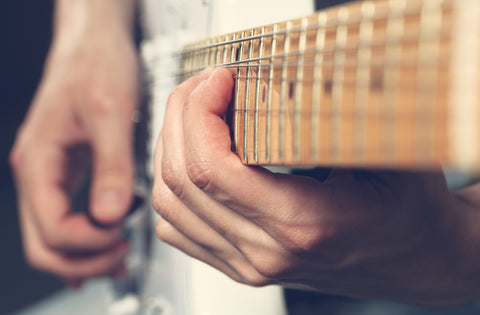-
Audio
-
Guitar
- Bass
-
Blog
-
SALE
- Financing
- Support
- SINCE 1946
June 29, 2016

There are thousands of effects pedals on the market today to choose from to sculpt your tone, and within that myriad of choices lies another one: buffered vs. true bypass. Ask a group of guitarists what their preference is, and you’ll likely get a bunch of responses favoring either one. This article will introduce the basic science behind buffered and true bypass pedals.
True bypass has become somewhat of a buzzword in recent years, with many manufacturers touting true bypass as a huge benefit. In a true bypass pedal, the footswitch connects the input jack directly to the output jack without touching any of the circuitry in between. As a result, your original signal is unaltered. With a true bypass model, you can remove the power to the pedal while your instrument is still plugged in and your signal will still pass through. This is a good way to test which of your pedals are actually true bypass!
Buffered pedals contain an electronic switching system and strengthen your guitar signal to maintain signal quality over long cable runs. A good way to remember this is to think about how they “buff up” your signal, hence their name. As a result of this process, the overall guitar tone and the way it is presented to your amplifiers input is altered, and based on which pedal is in question, may or may not be noticeable. For this reason, many guitar players favor true bypass models because they want to return to their original tone when bypassing the effect pedal.
To go deeper – An electric guitar’s output is high impedance, and the guitar amplifier’s input is high impedance. When a buffered pedal is inserted, it changes this relationship. Some models try to return the output of the buffer to a semi-high impedance and others change it to low impedance. This may or may not change your tone into your amp, but different amps and pedals respond differently. As your signal travels over long cable distances, the overall signal quality degrades, most notably resulting in a loss of high end. For more on this topic, check out our article about DI boxes by clicking here. So, using a setup of all true bypass pedals will actually have a negative effect on your tone if you are using long cables! At the same time, a buffered effects model with a lower output impedance can improve your long cable runs by restoring the high end frequency response of the pedal board output to the amp input.
While every musician will have their preference, there is ultimately a place for both types on everyone’s pedalboard. For instance, if you have a bunch of true bypass pedals, it would be beneficial to throw a buffered model in front of them to preserve your tone. They can co-exist peacefully and you don’t always have to choose one or the other!
March 28, 2025
At any time at any gig, something is bound to go wrong and you may need a tool to get you back up and running. Here are a few basic tools you should bring to every gig.
January 09, 2025
I once asked blues legend Walter Trout why he still plays his well-worn vintage Strat. The technology exists to digitally scan the guitar and make very accurate replicas. His response was he could leave it at home, but then it will never be played. Plus, someone could steal it from his home. At least the guitar is with him and he has the pleasure of playing it. But this may not be the same for everyone.
December 09, 2024
With modern day effects, it is possible to easily replicate guitar tones from early rock and roll in the 1950s to modern hard rock or metal.
Sign up to get the latest on sales, new releases and more…
NoFraud Frequently Asked Questions
"Make a joyful noise unto the Lord all of the earth; make a loud noise and rejoice and sing praises. Sing to the Lord with the harp and the voice of the psalm." - Psalm 98:4-5
© 2025 Carvin Audio.
Carvin Corp.
POS and Ecommerce by Shopify
